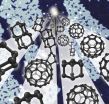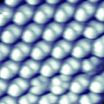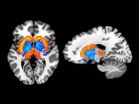(Press-News.org) Menlo Park, Calif. — Scientists have married two unconventional forms of carbon – one shaped like a soccer ball, the other a tiny diamond – to make a molecule that conducts electricity in only one direction. This tiny electronic component, known as a rectifier, could play a key role in shrinking chip components down to the size of molecules to enable faster, more powerful devices.
"We wanted to see what new, emergent properties might come out when you put these two ingredients together to create a 'buckydiamondoid,'" said Hari Manoharan of the Stanford Institute for Materials and Energy Sciences (SIMES) at the Department of Energy's SLAC National Accelerator Laboratory. "What we got was a basically a one-way valve for conducting electricity – clearly more than the sum of its parts."
The research team, which included scientists from Stanford University, Belgium, Germany and Ukraine, reported its results September 9, 2014 in Nature Communications.
Two Offbeat Carbon Characters Meet Up
Many electronic circuits have three basic components: a material that conducts electrons; rectifiers, which commonly take the form of diodes, to steer that flow in a single direction; and transistors to switch the flow on and off. Scientists combined two offbeat ingredients – buckyballs and diamondoids – to create the new diode-like component.
Buckyballs – short for buckminsterfullerenes – are hollow carbon spheres whose 1985 discovery earned three scientists a Nobel Prize in chemistry. Diamondoids are tiny carbon cages bonded together as they are in diamonds, but weighing less than a billionth of a billionth of a carat. Both are subjects of a lot of research aimed at understanding their properties and finding ways to use them.
In 2007, a team led by researchers from SLAC and Stanford discovered that a single layer of diamondoids on a metal surface can efficiently emit a beam of electrons. Manoharan and his colleagues wondered: What would happen if they paired an electron-emitting diamondoid with another molecule that likes to grab electrons? Buckyballs are just that sort of electron-grabbing molecule.
A Very Small Valve for Channeling Electron Flow
For this study, diamondoids were produced in the SLAC laboratory of SIMES researchers Jeremy Dahl and Robert Carlson, who are world experts in extracting the tiny diamonds from petroleum. They were then shipped to Germany, where chemists at Justus-Liebig University figured out how to attach them to buckyballs.
The resulting buckydiamondoids, which are just a few nanometers long, were tested in SIMES laboratories at Stanford. A team led by graduate student Jason Randel and postdoctoral researcher Francis Niestemski used a scanning tunneling microscope to make images of the hybrid molecules and measure their electronic behavior. They discovered the hybrid is an excellent rectifier: The electrical current flowing through the molecule was up to 50 times stronger in one direction, from electron-spitting diamondoid to electron-catching buckyball, than in the opposite direction. This is something neither component can do on its own.
While this is not the first molecular rectifier ever invented, it's the first one made from just carbon and hydrogen, a simplicity researchers find appealing, said Manoharan, who is an associate professor of physics at Stanford. The next step, he said, is to see if transistors can be constructed from the same basic ingredients.
"Buckyballs are easy to make – they can be isolated from soot – and the type of diamondoid we used here, which consists of two tiny cages, can be purchased commercially," he said. "And now that our colleagues in Germany have figured out how to bind them together, others can follow the recipe. So while our research was aimed at gaining fundamental insights about a novel hybrid molecule, it could lead to advances that help make molecular electronics a reality."
INFORMATION:
Other research collaborators came from the Catholic University of Louvain in Belgium and Kiev Polytechnic Institute in Ukraine. The primary funding for the work came from the U.S. Department of Energy Office of Science.
SLAC is a multi-program laboratory exploring frontier questions in photon science, astrophysics, particle physics and accelerator research. Located in Menlo Park, California, SLAC is operated by Stanford University for the U.S. Department of Energy Office of Science. To learn more, please visit http://www.slac.stanford.edu.
The Stanford Institute for Materials and Energy Sciences (SIMES) is a joint institute of SLAC National Accelerator Laboratory and Stanford University. SIMES studies the nature, properties and synthesis of complex and novel materials in the effort to create clean, renewable energy technologies. For more information, please visit simes.slac.stanford.edu.
SLAC National Accelerator Laboratory is supported by the Office of Science of the U.S. Department of Energy. The Office of Science is the single largest supporter of basic research in the physical sciences in the United States, and is working to address some of the most pressing challenges of our time. For more information, please visit science.energy.gov.
Citation: J. C. Randel et al, Nature Communications, 9 September 2014 (10.1038/ncomms5877)
Buckyballs and diamondoids join forces in tiny electronic gadget
Scientists craft 2 exotic forms of carbon into a molecule for steering electron flow
2014-09-09
ELSE PRESS RELEASES FROM THIS DATE:
Eating habits, body fat related to differences in brain chemistry
2014-09-09
People who are obese may be more susceptible to environmental food cues than their lean counterparts due to differences in brain chemistry that make eating more habitual and less rewarding, according to a National Institutes of Health study published in Molecular Psychiatry.
Researchers at the NIH Clinical Center found that, when examining 43 men and women with varying amounts of body fat, obese participants tended to have greater dopamine activity in the habit-forming region of the brain than lean counterparts, and less activity in the region controlling reward. Those ...
Study sheds light on how stem cells can be used to treat lung disease
2014-09-09
Munich, Germany: A new study has revealed how stem cells work to improve lung function in acute respiratory distress syndrome (ARDS).
Previous studies have shown that stem cells can reduce lung inflammation and restore some function in ARDS, but experts are not sure how this occurs. The new study, which was presented at the European Respiratory Society's International Congress today (09 September 2014), brings us a step closer to understanding the mechanisms that occur within an injured lung.
ARDS is a life-threatening condition in which the efficiency of the lungs ...
Birth measurements could predict lung health in teen years
2014-09-09
Munich, Germany: A new study has found that factors, such as birth weight, gestational age at birth and lung function, growth and other measures at 8 years, can be used to predict lung function during mid to late teenage years.
The study, presented at the European Respiratory Society (ERS) International Congress in Munich today (9 September 2014), is part of a growing area of research aiming to understand how early life factors have an impact on the development of disease into adulthood.
Data out of the Avon Longitudinal Study of Mothers and Children (ALSPAC) from ...
Idiopathic pulmonary fibrosis cases linked with asbestos exposure
2014-09-09
Munich, Germany: A proportion of idiopathic pulmonary fibrosis (IPF) cases may be linked with asbestos exposure, according to the results of a new study. If confirmed, the findings would mean that current treatment strategies need to be altered as people with a history of asbestos exposure are not currently able to access new treatments for IPF.
The research, which was presented at the European Respiratory Society's International Congress today (09 September 2014), provided new mortality data for IPF, asbestosis and mesothelioma.
Asbestosis is the name given to the ...
Milestone reached in work to build replacement kidneys in the lab
2014-09-09
WINSTON-SALEM, N.C. – Sept. 9, 2014 – Regenerative medicine researchers at Wake Forest Baptist Medical Center have addressed a major challenge in the quest to build replacement kidneys in the lab. Working with human-sized pig kidneys, the scientists developed the most successful method to date to keep blood vessels in the new organs open and flowing with blood. The work is reported in journal Technology.
"Until now, lab-built kidneys have been rodent-sized and have functioned for only one or two hours after transplantation because blood clots developed," said Anthony ...
Intervention in 6-month-olds with autism eliminates symptoms, developmental delay
2014-09-09
Treatment at the earliest age when symptoms of autism spectrum disorder (ASD) appear – sometimes in infants as young as 6 months old – significantly reduces symptoms so that, by age 3, most who received the therapy had neither ASD nor developmental delay, a UC Davis MIND Institute research study has found.
The treatment, known as Infant Start, was administered over a six-month period to 6- to 15-month-old infants who exhibited marked autism symptoms, such as decreased eye contact, social interest or engagement, repetitive movement patterns, and a lack of intentional communication. ...
Contrast-enhanced CT scan safe for most patients
2014-09-09
OAK BROOK, Ill. – According to new research performed at the Mayo Clinic, iodine-based contrast material injected intravenously to enhance computed tomography (CT) images can be safely used in most patients. The study appears online in the journal Radiology.
Of the 80 million or more CT scans performed each year in the United States, iodine-based contrast material is used in at least half to enhance computed tomography (CT) images, according to researcher Robert J. McDonald, M.D., Ph.D., a radiology resident at the Mayo Clinic in Rochester, Minn.
According to Dr. McDonald, ...
IU study links skipping school, failing tests to more sex, less condom use in teenagers
2014-09-09
INDIANAPOLIS -- What do skipping school, failing tests and engaging in risky sexual behavior have in common? Lots, according to Indiana University researchers who combed through 80,000 diary entries written by 14- to 17-year-old girls.
Although the findings are intuitive, this is the first study to examine the day-to-day relationship between teenage girls' reports about school-related events, how they felt and the sexual behaviors they participated in. Published Sept. 9 in the Journal of Adolescent Health, the findings are based on a 10-year study of the development of ...
Researchers identify novel virus that could cause respiratory disease in ball pythons
2014-09-09
Researchers have identified a novel virus that could be the source of a severe, sometimes fatal respiratory disease that has been observed in captive ball pythons since the 1990s. The work is published this week in mBio®, the online open-access journal of the American Society for Microbiology.
Investigators observed the virus, which they named ball python nidovirus, in eight snakes with pneumonia; virus levels were highest in the animals' lungs and other respiratory tract tissues. The team also sequenced the genome of the virus, finding it to be the largest of any RNA ...
Breast milk may be protective against devastating intestinal disorder
2014-09-09
Premature infants are at increased risk for a potentially lethal gastrointestinal disease called necrotizing enterocolitis, or NEC. Studies conducted by researchers at Children's Hospital Los Angeles demonstrate that a protein called neuregulin-4 (NRG4)—present in breast milk, but absent from formula—may be protective against the intestinal destruction caused in NEC. Their results will be published online on September 9 in advance of the print edition of the American Journal of Pathology.
Thirty percent of babies with NEC die from their disease, and even survivors can ...
LAST 30 PRESS RELEASES:
SIMJ announces global collaborative book project in commemoration of its 75th anniversary
Air pollution exposure and birth weight
Obstructive sleep apnea risk and mental health conditions among older adults
How talking slows eye movements behind the wheel
The Ceramic Society of Japan’s Oxoate Ceramics Research Association launches new international book project
Heart-brain connection: international study reveals the role of the vagus nerve in keeping the heart young
Researchers identify Rb1 as a predictive biomarker for a new therapeutic strategy in some breast cancers
Survey reveals ethical gaps slowing AI adoption in pediatric surgery
Stimulant ADHD medications work differently than thought
AI overestimates how smart people are, according to HSE economists
HSE researchers create genome-wide map of quadruplexes
Scientists boost cell "powerhouses" to burn more calories
Automatic label checking: The missing step in making reliable medical AI
Low daily alcohol intake linked to 50% heightened mouth cancer risk in India
American Meteorological Society announces Rick Spinrad as 2026 President-Elect
Biomass-based carbon capture spotlighted in newly released global climate webinar recording
Illuminating invisible nano pollutants: advanced bioimaging tracks the full journey of emerging nanoscale contaminants in living systems
How does age affect recovery from spinal cord injury?
Novel AI tool offers prognosis for patients with head and neck cancer
Fathers’ microplastic exposure tied to their children’s metabolic problems
Research validates laboratory model for studying high-grade serous ovarian cancer
SIR 2026 delivers transformative breakthroughs in minimally invasive medicine to improve patient care
Stem Cell Reports most downloaded papers of 2025 highlight the breadth and impact of stem cell research
Oxford-led study estimates NHS spends around 3% of its primary and secondary care budget on the health impacts of heat and cold in England
A researcher’s long quest leads to a smart composite breakthrough
Urban wild bees act as “microbial sensors” of city health.
New study finds where you live affects recovery after a hip fracture
Forecasting the impact of fully automated vehicle adoption on US road traffic injuries
Alcohol-related hospitalizations from 2016 to 2022
Semaglutide and hospitalizations in patients with obesity and established cardiovascular disease
[Press-News.org] Buckyballs and diamondoids join forces in tiny electronic gadgetScientists craft 2 exotic forms of carbon into a molecule for steering electron flow




